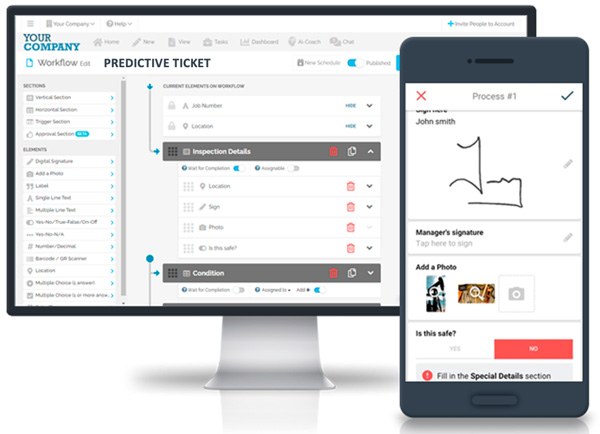Union Pacific Railroad, the largest railroad company in the USA, adopted big data for maintenance optimization.
Thermostats and visual sensors are placed on the underside of each of its rail carriages to detect and analyze imminent problems with tracks and wheels. Additionally, they have deployed a fiber optic communications network throughout its rail system to transmit the data collected.
The visual sensors alone are able to reduce bearing-related derailments by 75%. This is done by shooting ultrasound visuals that can detect when wheels begin to flatten.
This is just one example of the immense benefits that real-time analytics can bring to an organization. Using such real-time information to facilitate maintenance is what predictive maintenance is all about.
Predictive maintenance is a data-driven approach that leverages technology to monitor equipment health, identify faults, and plan for maintenance effectively.
The adoption of predictive maintenance is beneficial for organizations in various ways. For instance, it reduces downtime, enhances equipment reliability, and optimizes maintenance.
FAT FINGER offers a no-code builder to create enterprise-grade mobile applications that can facilitate predictive maintenance.
Your predictive maintenance checklist should include the following:
- Goals and objectives
- Visual inspections
- Data management system
- Regular equipment monitoring
However, before you begin implementing a predictive maintenance strategy, you need to understand its most common technologies.
Technologies Used for Predictive Maintenance
Predictive maintenance uses proactive measures to detect issues in a facility before they become serious problems.
Unlike preventive maintenance, predictive maintenance does not rely on schedules to conduct inspections. Instead, it uses data and technology to accurately specify when maintenance needs to be completed.
Different technologies are used to collect data from your facility’s various equipment.
FAT FINGER then processes the data with algorithms and artificial intelligence, and the results reveal potential issues before they cause equipment failures or unplanned downtime.
The most important technologies to consider when creating your predictive maintenance checklist are vibrational analysis, oil analysis, thermography, emission testing, and lubrication analysis.
Vibration Analysis
This technology monitors the vibrational levels of equipment to detect changes that may indicate wear, misalignment, or other issues.
It can be used to predict mechanical failures before they occur, and is especially used on the moving parts of equipment, such as motors, pumps, fans, and gearboxes.
The following equipment is used to collect the data:
- Vibration meter: Measures the vibration levels of equipment
- Accelerometer: Measures the acceleration of equipment
For example, you can use it to monitor the vibration levels of a pump.
If the tool detects an increase in vibration levels over time, this indicates that the pump bearings are wearing out. Maintenance personnel can then use this information to schedule repairs before the pump fails. This also applies to motors, fans, and gearboxes.
Oil Analysis
This involves analyzing the lubricating oil used in equipment to identify potential issues such as contamination, degradation, or wear and tear.
Examples of equipment that benefit from oil analysis include engines, gearboxes, and hydraulic systems.
Oil analysis also provides information on the overall health of the equipment, the expected remaining useful life, and identifies any needed maintenance or repairs.
Data is collected using the following equipment:
- Oil analysis kit: Typically includes sampling bottles, sampling pumps, and pre-addressed envelopes for sending the samples to a laboratory for analysis
- Spectrometer: Used to measure the elemental composition of the oil sample
- Ferrograph: Used to analyze the wear particles in the oil sample
For example, it can be used to detect wear particles in the oil of a gearbox.
If wear particles are present, this may indicate that the gears are wearing out. Maintenance personnel can then use this information to schedule repairs or replace the gearbox before it fails.
Thermography
This uses infrared technology to measure the temperature of equipment to identify potential issues such as overheating, electrical faults, or insulation problems.
This is done by detecting abnormal heat patterns. Heat patterns provide information on the overall health of the equipment.
Common equipment that benefits from thermography includes electrical panels, motors, and transformers.
Thermography collects data using the following equipment:
- Infrared camera: Used to measure the temperature of equipment to identify hot spots
- Thermal imaging software: Used to analyze the thermal images and detect abnormal heat patterns
- Temperature probes: Can be used to measure the temperature of specific components
For example, thermography can be used to detect abnormal heat patterns in an electrical panel. If the infrared camera detects a hotspot, this may indicate that the component is failing or there is an issue with the insulation.
Maintenance personnel can then use this information to schedule repairs before a failure occurs.
Emission Testing
This involves measuring the emissions from a piece of equipment to detect issues with combustion, fuel delivery, and other emission-related processes.
It can be used to predict engine failures, detect issues with fuel injectors, and improve fuel efficiency.
Equipment that can benefit from emission testing include generators, boilers, and industrial furnaces.
Emission testing collects its data using the following equipment:
- Emissions analyzer: Used to measure the emissions from equipment
- Gas analyzer: Used to measure the concentration of specific gasses in emissions
- Smoke meter: Used to measure the opacity of emissions
For example, emission testing can be used to detect issues with a boiler.
If the test shows the boiler producing high levels of emissions, this may indicate that there is an issue with the boiler’s fuel delivery system.
Maintenance personnel can then use this information to schedule repairs or adjust the fuel delivery system before failure occurs.
Lubricant Analysis
This involves analyzing the condition of lubricants in equipment to detect contaminants or wear particles.
This technology can be used to predict equipment failures, detect impending issues, and extend the life of equipment.
Equipment that can benefit from this technique include engines, gearboxes, and hydraulic systems.
Lubricant analysis collects data using the following equipment:
- Viscometer: Used to measure the viscosity of lubricants
- Particle counter: Used to measure the number and size of wear particles in the lubricant
- Karl Fischer titrator: Used to measure the amount of water in lubricants
For example, the technology can be used to detect contaminants in the oil of an engine.
If it indicates that the oil is contaminated, this means that there is an issue with the filtration system or that the engine is wearing out.
Maintenance personnel can use this information to schedule repairs or replacement of the engine before it fails.
All the data collected by these technologies can be integrated into FAT FINGER’s predictive maintenance workflow.
With our intuitive workflow, you can drag and drop digital procedures, control scheduling, and manage your predictive maintenance checklist to keep your equipment running at peak performance.
Developing a Predictive Maintenance Checklist

Now that you are familiar with the technologies used in predictive maintenance, you need to develop a predictive maintenance checklist.
A predictive maintenance checklist will guide your frontline workers to efficiently implement your predictive maintenance technologies; from creating goals and objectives, to conducting visual inspections, establishing a data management system, and finally monitoring your equipment.
1 – Establish Goals and Objectives
The first step in developing a predictive maintenance plan is establishing goals and objectives.
The goals should be aligned with your overall business objectives and focus on improving the reliability, availability, and maintainability of critical assets.
Your goals and objectives should be guided by the impact of your predictive maintenance on your operational excellence.
FAT FINGER’s open API is able to analyze the input data and present it in the following metrics:
- Mean Time Between Failures (MTBF): MTBF is the average time between failures in a piece of equipment. It is a measure of the reliability of the equipment and can be used to set goals for improving equipment reliability.
By tracking MTBF over time, maintenance teams can identify equipment that is prone to failure and prioritize maintenance as needed to improve reliability.
Setting a goal to increase MTBF can help maintenance teams reduce unplanned downtime, improve equipment availability, and increase productivity.
- Overall Equipment Effectiveness (OEE): OEE is a measure of how effectively equipment is being used.
It takes into account three factors: availability (the percentage of time that equipment is available for use), performance (the speed at which equipment is operating compared to its maximum potential), and quality (the percentage of products produced that meet quality standards).
OEE can be used to set goals for improving equipment efficiency and productivity. By tracking OEE over time, maintenance teams can identify areas for improvement and prioritize maintenance activities to improve efficiency and productivity.
Setting a goal to increase OEE can help maintenance teams reduce waste, improve quality, and increase profitability.
2 – Conduct Visual Inspections
The next step of your predictive maintenance plan is to personally inspect your equipment.
During this step, you will be able to identify your critical assets and decide on the right technologies to implement for each piece of equipment.
Critical assets should be prioritized based on their impact on the business and their contribution to the bottom line.
To conduct a thorough visual inspection, follow these steps:
- Review facility processes: Review how your facility operates and identify assets that are critical in each production process.
This may include equipment that is essential to the production process, equipment that is difficult or expensive to replace, or equipment that has a high impact on safety or environmental compliance.
- Conduct risk assessments: Assess the risks associated with every piece of equipment identified in the first step.
This involves evaluating the potential consequences of asset failure, including the impact on safety, the environment, production schedules, and maintenance costs.
Assets with the highest risk and impact are considered critical assets.
- Review maintenance records: Maintenance records can provide valuable information about the reliability and maintenance history of each asset.
By reviewing maintenance records, maintenance teams can identify assets that require frequent maintenance or have a history of failures.
Assets that have a high maintenance history or require frequent repairs are considered critical assets.
- Consider age and condition: The age and condition of assets can be used to classify them as critical. Older equipment may have a higher risk of failure and require more frequent maintenance.
Assets that are in poor condition or have a history of failures are considered critical assets.
- Evaluate overall importance: Finally, it is important to consider the overall importance of each asset to the facility’s operations.
Assets that are critical to the production process have a high impact on safety or environmental compliance, or have a significant impact on maintenance costs are considered critical assets.
While inspecting to identify your critical assets, you can also eliminate any visible issues through preventive maintenance before you apply any predictive maintenance technologies.
The technologies you decide to use will require a data management system to make sense of all the data collected.
3 – Establish a Data Management System
Whether you are conducting a vibration analysis, oil analysis, lubricant analysis, emission testing, or thermography, a data management system will help you make sense of all the data collected.
At FAT FINGER, we offer the easiest and most flexible digital procedures in the world. It is in your best interest to adopt our data management system.
You will be able to build and deploy enterprise-grade mobile applications that can collect your data using an easy drag-and-drop, no-code builder.
- Identify data requirements: Identify the data requirements for each type of analysis. This includes the types of data that will be collected, the frequency of data collection, and the format in which data will be stored.
- Create your app: Once the data requirements have been identified, use our drag-and-drop digital procedures to create an app that accommodates your data requirements.
The application should be able to integrate data from different sources, provide real-time coaching and analysis, and generate reports that provide actionable insights and recommendations.
This video shows you a step-by-step procedure for building an application using our platform.
- Establish data collection procedures: Each type of analysis should involve different data collection procedures. This includes procedures for collecting and storing data, as well as procedures for monitoring and analyzing data in real time.
- Train personnel: All personnel involved in data collection, monitoring, and analysis should be trained in the use of the data management application and data collection procedures.
This will ensure that the data is collected and analyzed consistently and accurately.
- Implement data analysis tools: Implementing data analysis tools will help you identify trends and patterns in data. These tools can include statistical analysis, machine learning algorithms, and predictive modeling techniques.
All you need to do is incorporate these commands in the applications you build. Indicate what kind of output you need from our platform, whether it is MTBF or OEE.
- Establish data storage and backup procedures: This will ensure that your data is secure and accessible in case of a system failure or other issues.
Since our platform is cloud-based, your data will always be secure. Even when you have no internet access, your application will still be able to collect the data and synchronize it with our cloud once you get internet access.
Bonus Tip: Apply predictive algorithms to historical data to detect patterns and anticipate equipment failures, enabling timely maintenance interventions.
4 – Regularly Monitor Equipment Condition

Once you have established your goals and objectives, conducted a visual inspection, and established a data management system, it is time to monitor your equipment condition.
This is where FAT FINGER comes in. By regularly monitoring your equipment condition, FAT FINGER will identify potential issues before they cause downtime.
For example, by conducting an oil analysis on a piece of equipment, we will identify when it needs to be serviced before it runs low on oil and causes damage.
It will regularly conduct vibration analysis, oil analysis, lubricant analysis, emission testing, or thermography on your equipment as needed.
Then, it will provide the mean time between failures, overall equipment effectiveness, and equipment downtime.
Frontline workers can then use this data to determine the maintenance measures they need to implement. Whenever a piece of equipment shows signs of failure, they can quickly make the necessary repairs.
By identifying potential issues early on, you can take corrective action and reduce maintenance costs.
Predictive maintenance has a significant impact on performance metrics.
According to a report by Deloitte, predictive maintenance increases productivity by 25%, reduces breakdown by 70%, and lowers maintenance costs by 25%.
As if that’s not enough, it also guarantees your organization the following benefits:
- 5–10% material cost savings
- 5–10% reduced inventory carrying costs
- 10–20% increased equipment uptime and availability
- 20–50% reduced maintenance planning time
- 5–10% reduced overall maintenance costs
- Improved health, safety, and environment (HSE) compliance
- Less time spent on brute-force information extraction and validation
- More time spent on data-driven problem-solving
- Clear linkages to initiatives, performance, and accountability
- More confidence in data and information leading to ownership of decisions
By tracking performance metrics and analyzing data, organizations can make data-driven insights to optimize asset reliability, reduce maintenance costs, and increase equipment uptime.
Expert Tip: Use advanced sensors and monitoring technologies to automate the collection of equipment data for real-time analysis and proactive maintenance.
Maximizing Efficiency With FAT FINGER’s Services

FAT FINGER uses machine learning to coach app users in real-time to make safer decisions that promote frontline worker efficiency.
As a result, it makes more sense to use our platform for predictive maintenance than for preventive maintenance.
But does this mean that predictive maintenance is ultimately better than preventive maintenance?
The answer is no.
Let us clarify, predictive maintenance is more accurate and saves time than preventive maintenance. However, you will still have to incur the costs of implementing sensors and data analytics. Therefore, it is only advisable to adopt predictive maintenance if you can afford it.
Take the Union Pacific Railroad case, for example. It is the largest railroad company in the USA with over 8,000 locomotives. It makes more sense for them to adopt predictive maintenance because small errors can result in vast delays. With over 3,000 trains operating on any given day, such delays can be very expensive.
Here is a table that shows how FAT FINGER’s predictive maintenance compares to our preventive maintenance.
| Key Differences | FAT FINGER’s Predictive Maintenance | Preventive maintenance |
| Approach | Data-driven | Schedule-driven |
| Equipment Condition | Monitors equipment condition and predicts when maintenance is needed | Assumes that maintenance is needed at a fixed interval regardless of equipment condition |
| Cost | Higher initial cost due to implementation of sensors and data analytics | Lower initial cost due to simple scheduling of maintenance activities |
| Downtime | Reduced downtime due to early identification of potential failures | Increased downtime due to maintenance being performed regardless of equipment condition |
By working with FAT FINGER, you can benefit from the predictive approach to maintenance to avoid costly downtime and repairs.
Action: Stay on top of your predictive maintenance by signing up for a free trial of FAT FINGER’s central asset management platform.
Adopt Predictive Maintenance

Embracing a predictive maintenance strategy can bring about significant benefits to your organization’s operational efficiency. Predictive maintenance provides organizations with an opportunity to identify equipment issues and prevent downtime before it happens.
By employing different technologies, businesses can predict faults, perform timely maintenance, and save on maintenance costs in the long term.
To successfully implement predictive maintenance, you need to develop a comprehensive maintenance plan tailored to your organization’s unique needs. Establish goals and objectives, conduct visual inspections, and establish a data management system before using FAT FINGER to monitor your equipment.
Our platform will continuously track performance metrics such as equipment effectiveness, and mean time between failures, and aim to improve upon them where possible.
“We highly recommend FAT FINGER for anyone who needs to stay on top of machine maintenance.” – Patrick Davis, Maintenance Department Head
Our goal is to offer the easiest and most flexible digital procedures in the world. Visit us today and enjoy our asset management services.
Share on LinkedIn



